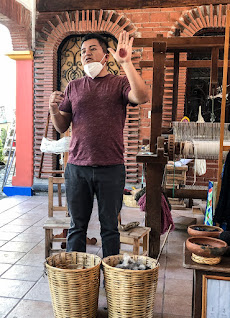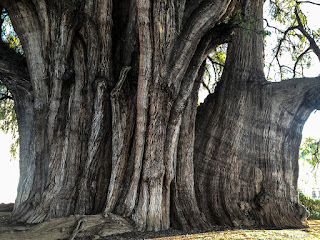
We used to scoff at bus trips, but after traveling to Oaxaca on David (pronounced Da-veed) Rico's Los Vagabundos trip, we are converts. The long trip to Oaxaca was broken up into two parts with an overnight in Puebla along the way. On the second day we passed through some rugged, mountainous scenery on Highway 135D. (Click for larger photos-best viewed on laptop or desktop computer)
Just a couple of hours outside Oaxaca, David was notified that the garbage collectors and other municipal employees were on strike because they had not received their aguinaldo, the bonus of two weeks pay that all employees in Mexico are entitled to receive by December 20th. Because they didn't get theirs, they struck on the 21st, and the garbage workers used their trucks to block all entrances to the city. There was no way for our bus to get through, so David organized a fleet of taxis to meet us inside the barricades. We hiked a few blocks, and then the taxis whisked us to our hotel taking a very bizarre route to avoid more roadblocks. We are very glad we were not doing this trip on our own because we would have had no idea what was going on or what to do about it. Our luggage miraculously appeared in our hotel room later that evening after being hand-carried through the blockade and loaded onto a truck.
We had a fabulous dinner, including an insect course, that night to celebrate my birthday. See previous post for details.
Our first side trip was to Mitla, a pre-Columbian archaeological site which was an important religious site for the Zapotec people. It is about 44 kilometers from Oaxaca City and is located in the town of San Pablo Villa de Mitla. Mitla was still occupied and active when the Spanish arrived.
The geometric designs covering the buildings are intricate and found at no other site in Mexico. They are made of small stone pieces put together without mortar. Missing areas cannot be restored because, according to our guide, no one has been able to figure out how it was done. Originally, the buildings were red in color providing a bright background for the decorations.
After Mitla, we went to Teotitlan del Valle, famous for its excellent wool weaving. As seems to be typical in Mexico, the entire town is devoted to this craft and weaving workshops abound. We enjoyed the visit to The Bug in the Rug workshop and gallery, home of J. Isaac Vasquez and Family, the oldest weaving family in town. The founder of this business has been featured in several books. This workshop does everything by hand from carding the wool to weaving and uses all pre-Hispanic natural dyes. We were given a demonstration of how the dyes are created from various plants and minerals. Of course we did some shopping afterwards purchasing two small rugs and a wall hanging.
 | | Dye materials |
|
 | | Work in progress |
|
Next it was on to the town of Santa Maria del Tule to see the famous tree, a Montezuma cypress that is the stoutest tree in the world with a diameter of more than 30 feet. It is over 116 feet high and towers over the church next to it. Tourists flock to this town with its well-manicured park to see it.
The next morning we headed for Monte Albán, a massive pre-Columbian archaeological site on a high, artificially leveled ridge looking down on the city of Oaxaca. It was one of the earliest cities in Mesoamerica and for about one thousand years was the social, political and economic center of the Zapotec civilization. It is truly magnificent, but we were sad that the museum was closed due to Covid restrictions.
 | | Overlooking Oaxaca |
|
 | Unexcavated building
|
|
 | | The Sunken Plaza |
|
 | | Our guide Antonio explaining |
|
 | | The Main Plaza |
|
|
In the afternoon we headed for San Bartolo Coyotepec, a town famous for its black pottery. A demonstration at the Doña Rosa workshop showed how the clay is transformed by hand into pots and objects of all kinds. A bit more shopping was required, naturally.
 |
| The pot we bought |
As an extra side trip, some of us went to San Martin Tilcajete, another craft town famous for alebrijes, beautifully, intricately painted fantastical wooden animals. We watched a demonstration about the wood used and the natural dyes at the workshop of Jocobo and María Ángeles, and then walked through the building seeing how the objects are made.
In a brilliant marketing ploy, we were each told, based on our birth date, what our spirit protector animal is, so of course, we had to buy them. Mine is a coyote and Erich's is a turtle.
At another workshop owned by David Hernandez and family, we bought a wonderful praying mantis. All of the legs, wings and antennae come off making it easy to pack.
While we enjoyed our trip to Oaxaca and nearby communities, we did not see Oaxaca at its best. Because of the strike, there was garbage all over the city and a lot of places we wanted to visit, including the cultural museum, were closed because of Covid. The Radish Festival, which was supposed to be one of the highlights of the trip, was cancelled because participants couldn't get past the barricades. My husband was very disappointed that our all-day tour of artisanal mescal producers was cancelled because our guide didn't know how to get into the city. Erich had to console himself with buying some special mescal at a store called In Situ Mescaleria.
On our way back to Puebla we were treated to views of Pico de Orizaba, an inactive volcano and the highest peak in Mexico and close to Puebla, Popocatépetl, an active volcano, was smoking. The iPhone photos from the moving bus leave something to be desired.
All in all, a good trip.































3 comments:
Great synopsis Cynthia. Hope to see you again on our next trip. Ilene
Thanks you, Cynthia. Very interesting. I have seen one of those intricate colored animal figures and had no idea of what they were or where they came from.
No photos of the insect meal? I think I would like to know and see more about that. And I am interested in the nature of group travel in this era of COVID in Mexico. Masks? Vaccinations?
You are living an interesting life and some of your readers want more insight into it.
Again, thanks.
The photo of the insect dish is on the previous blog post.
On all of the Los Vagabundos trips, masks are required and everyone must show proof of vaccination before departure. Little bottles of hand sanitizer were handed out. In Mexico, masks are not controversial and almost everybody wears them. All waiters and store clerks wear them. In all shops and restaurants, your temperature is checked and hand sanitizer is provided. Tables are disinfected after each use. I feel safer from Covid here than in the USA, but with Omicron coming, we will limit our social interactions until it passes.
Post a Comment